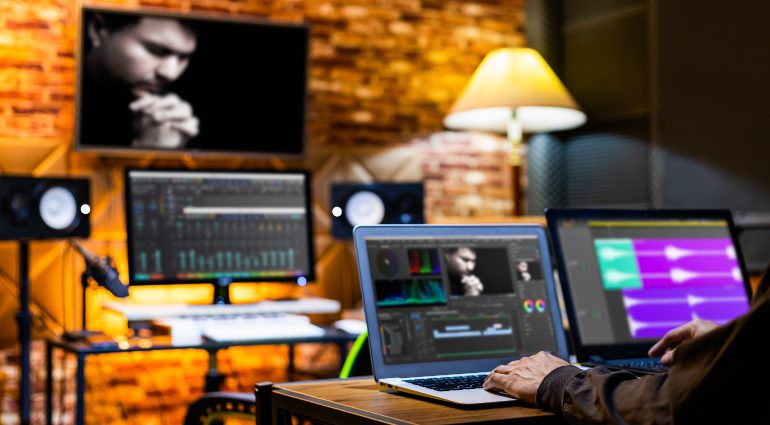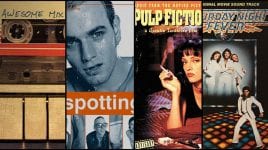
Movies without music would be… boring, to say the least. Movies soundtracks get as much recognition as the movie itself, and with good reason – we can’t forget those memorable Ennio Morricone OSTs (Original Sound Tracks) that turned good movies into masterpieces. BUT, there’s a lot more to a movie “sound” department than music: today we’ll talk about all the sounds (foley), effects (and dialogues too) that you can find in a movie and how they are made.
Film sound designers are a key figure in a movie’s development: they make sure that the dialogues are loud and clear, that the balance between sound effects, music and dialogues is optimal and that every little piece falls into place in order to create a unique audio-visual experience.
The definition of sound design
You are currently viewing a placeholder content from YouTube. To access the actual content, click the button below. Please note that doing so will share data with third-party providers.
Sound design was developed alongside the whole filmmaking process, starting 1926. Warner Bros’ “Don Juan” was the first movie to feature sound synchronised to the images – bear in mind, we’re not talking about dialogues (yet), it was just music and sound effects – but it was pretty revolutionary for the time.
Moreover, creating a soundtrack for a feature film is a LOT of work and nowadays, sound teams are comprised of different figures with different tasks – up to the point where the Academy Awards are, in fact, handled for the “Best Sound Editing” category and the “Best Sound Mixing“, and that tells you a little bit about how complicated, diverse and multi-layered the process of creating sounds for a movie is.
The sound effects
You are currently viewing a placeholder content from YouTube. To access the actual content, click the button below. Please note that doing so will share data with third-party providers.
Sound designers are responsible for bringing the movie scenes to life with the addition of sounds (you didn’t think thunderstorms and blizzard sounds were recorded while the scenes are shot, did you?) which are, most of the time, taken from sound effect libraries, commercially available to sound creators and professionals.
To have more unique sounds to differentiate from other movies, or simply because a sound that can’t be found in the library is required, sound editors may need to create/record new sounds. In The Irishman, Scorsese’s attention to detail went one step further, having his team re-create the sound of every single car featured in the movie to match the real world version of it – this required several days on the field, recording the engine sounds from different rented cars. Talk about commitment.
Creating new sounds is not always a 1:1 type of application: sometimes you have to be creative and come up with … “alternative” solutions: sounds used in “A Quiet Place” were achieved by crushing and handling different vegetables and hitting items in weird ways (and then adding effects in post) to get the creatures sounds. “Bird Box“, streaming on Netflix, featured a “deprived sense” concept in its plot and the creatures, which were identified by sounds because it wasn’t possible to look at them, were voiced with a mix of whispers and bee sounds.
The art of Foley
You are currently viewing a placeholder content from YouTube. To access the actual content, click the button below. Please note that doing so will share data with third-party providers.
If the creation of new sounds wasn’t enough, there’s also another discipline named Foley, which is similar to custom-sound creation but it’s happening in real time, while the sound creators look at the current scene: kinda similar to how voice dubbing is achieved, by recording in real time as the scenes go by. Inside those studios, people are stomping, jumping, beating stuff or shouting while checking the footage in real-time. Wooden doors that haven’t seen oil in ages are used to mimic the “creaky boat” effect, for example.
“The Hateful Eight” is a great example: since Tarantino had to re–record dialogues (which is something he doesn’t like to do), all the ambient noises were gone too. His sound editor spent over 200 hours to re-create every-single noise, from the simple footsteps of every character walking on the scene to scrapes, clangs, chair movements and much much more. Hard work!
Dialogue
You are currently viewing a placeholder content from YouTube. To access the actual content, click the button below. Please note that doing so will share data with third-party providers.
All the good sounds and music would fall short if the most important part of the movie is not perfect: the dialogues. There’s a whole team dedicated to that, that makes sure that every part of the speeches and talking is crystal clear.
To guarantee a good result, is a common practice to have the extras being completely silent. Even if there’s a scene where a crowd is supposed to make noise, they will only mime that – the cheering sounds and the yelling are added in post, in order to focus, during the filming, on the main characters‘ dialogue.
Mixing everything together
https://www.youtube.com/watch?v=z–J_eZZvkY
The final part is the mixing process: similar to what happens in music mixing, it’s aim is to bring down the louder noises, raise the lower ones and have a nice balance of speech, effects, noises and background music.
The choice of mixing is also an artistic tool to better convey the message of the movie: on “There Will Be Blood“, mixer Michael Semanick utilised the soundtrack rawness to intensify the sense of violence in the movie. When the oil rig explodes, a mix of quiet and loud moments contributes to a sense of restlessness. A work of art.
The end result? You decide
There are good movies and then there are great movies. Can you recall one of them that gave you goosebumps? Try to remember if it was purely because of the plot or if the sound, music and mixing choices helped to achieve the result: you may be surprised.
Which movie has the best sound design of all time? Let us know with a comment!
5 comments
Leave a Reply
You are currently viewing a placeholder content from Facebook. To access the actual content, click the button below. Please note that doing so will share data with third-party providers.
More InformationYou are currently viewing a placeholder content from Instagram. To access the actual content, click the button below. Please note that doing so will share data with third-party providers.
More InformationYou are currently viewing a placeholder content from X. To access the actual content, click the button below. Please note that doing so will share data with third-party providers.
More Information





Chris Klein says:
I enjoyed watching live dramas. If you have the same passion as me, install repelisplus live to experience. This app will help you watch live TV series for free.
Chiranjit Gope says:
I liked your website very much, because I got the content of my choice, that’s why I will keep visiting your blog daily. If you want to check my website, then you can check it from here
Pubg Name
robert says:
I want to learn more about movie sound thanks for sharing
https://krnl.sbs/
Tomlatham234 says:
I’m not sure where you’re getting your info, but good topic. I needs to spend some time learning much more or understanding more. Thanks for fantastic info I was looking for this info for my mission.
doramasmp4 says:
Thank you for the fantastic information! I was searching for this for my project.